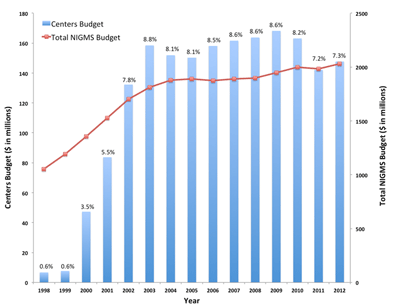There have been a lot of discussions lately at NIGMS about large-scale research initiatives and centers. In these conversations, we have drawn a distinction between initiatives and centers focused mainly on research and those focused mainly on resources. Examples of the latter include our human cell repository, synchrotron light sources, and databases, all of which serve the biomedical community in critical ways and, in most cases, require sustained support. In contrast, many of us feel that the primary purpose of research-focused initiatives and centers is to open untapped scientific areas, providing an initial, targeted investment that enables the research to develop sufficiently so that it can be sustained through other grant mechanisms, such as R01s and P01s.
Our discussions have led to the question of whether, when and how research initiatives and centers should be ended. Should all new research initiatives and centers have hard “sunset clauses” built into them, for example at 10 years, similar to what is done for projects funded by the NIH Common Fund? Or should it be possible for them to continue indefinitely as long as they are sufficiently productive?
An additional consideration is that many of our currently funded initiatives and centers were developed during the period in which the NIH budget was doubling (see figure). With a large infusion of new investment into biomedical research, it made sense to use a significant portion of the funds to open up new scientific territory through large-scale exploration in ways that were not previously possible.
In the current budget environment, in order to start a new program or bolster support for existing priorities such as investigator-initiated research, other programs must be adjusted or ended.
These issues will be central as we begin a strategic planning process to ensure that we are using the most effective and efficient mechanisms to invest the taxpayers’ money in fundamental biomedical and behavioral research. We have already begun carefully examining our existing portfolio of research initiatives and centers and considering how to balance continued support for them with other priorities and opportunities.
At last week’s National Advisory General Medical Sciences Council meeting, Council members and staff discussed the future of one existing large-scale program, the Protein Structure Initiative (PSI). The Council heard the results of a midpoint evaluation of the PSI’s third 5-year phase, PSI:Biology. The evaluators found that PSI investigators have determined an impressive number of high-quality protein structures and that some of the program’s accomplishments, including methodological ones, could not have been readily achieved through R01-type investigator-initiated grants.
The evaluators concluded that the PSI will reach a point that no longer justifies set-aside funding and, as a result, strongly recommended that NIGMS begin planning the sunset of the PSI, being careful to identify resources developed by the initiative that should be retained for use by the biomedical community.
After numerous internal discussions and consultation with the Council, we have decided to follow this advice and begin planning to sunset the PSI in its current format after the completion of PSI:Biology in 2015. We are setting up two transition-planning committees, one made up of NIGMS staff and representatives from several other parts of NIH, and a second made up of scientists from the research community. These committees will work together to recommend the best methods for phasing out the program and identifying critical resources that should be retained. The committees will also suggest emerging challenges and opportunities in structural biology that may require new, smaller-scale targeted support.
The committees and NIGMS will need a great deal of input from the biomedical community as this transition-planning process moves forward. I hope that you will freely share your thoughts and suggestions with us, now and in the future.


